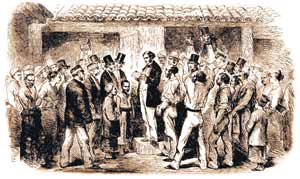Start of the
Pigeon Express
On September 24, 1850, the Pigeon
Express was successfully started from Galle to
Colombo by the 'Observer' newspaper.
 |
| Reading the news of the
fall of Sebastapool being read after the Pigeon
Post brought the news to Colombo. |
Renowned journalist H. A. J.
Hulugalle describes the event thus: In 1850 Galle
was still the chief port of call for ships from
England. The English mail coach from Galle to
Colombo took nine or ten hours. The delay in bringing
the news induced the Observer to start a Pigeon
Express for the most urgent news. It brought such
items to Colombo in less than two hours, sometimes
in three-quarters of an hour with favourable winds.
A narrow open yard ran down the middle of the
Baillie Street office where the pigeons were kept.
The first news brought by the
Pigeon Express was the announcement of the recall
of the Governor, Lord Torrington. The news of
the fall of Sebastapool and of the Battle of Inkerman
too reached Colombo on a thin quill of paper tied
to the leg of an Observer pigeon.
Rajakariya abolished
Compulsory service known as
rajakariya was prevalent in Sri Lanka ever since
the monarchy was established in the Anuradhapura
period. It was a service done free for the king.
In other words the king forced the people to work
for him without payment.
Rajakariya was used in the construction
of the huge irrigation tanks. Certain services
were based on caste. By the time of the Kandyan
era, the people were very unhappy with this system.
The building of the Kandy lake and the pattirippuwa
(octagonal tower) around 1806 A.D, were done using
forced labour. They added greatly to the beauty
of the Kandy town. But the people felt they were
done at the cost of much suffering to them and
increased the unpopularity of the king.
Temple lands were exempted from
this service. By the 17th and 18th centuries,
rajakariya was used for public works such as the
construction of roads, bridges and tanks. During
the British administration, they too used the
system to their advantage.
They made it more efficient
and more profitable. However, certain officials
viewed it as obnoxious to British principles of
justice. Ultimately rajakariya was abolished on
September 28, 1932 during Governor Sir Robert
Wilmot Horton's time. |
